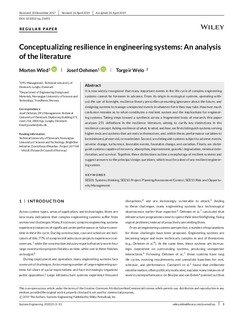Conceptualizing resilience in engineering systems: An analysis of the literature
| dc.contributor.author | Wied, Morten | |
| dc.contributor.author | Oehmen, Josef | |
| dc.contributor.author | Welo, Torgeir | |
| dc.date.accessioned | 2020-01-30T12:01:50Z | |
| dc.date.available | 2020-01-30T12:01:50Z | |
| dc.date.created | 2020-01-15T20:33:06Z | |
| dc.date.issued | 2019 | |
| dc.identifier.citation | Systems Engineering. 2019, 23 (1), 3-13. | nb_NO |
| dc.identifier.issn | 1098-1241 | |
| dc.identifier.uri | http://hdl.handle.net/11250/2638854 | |
| dc.description.abstract | It is now widely recognized that many important events in the life cycle of complex engineering systems cannot be foreseen in advance. From its origin in ecological systems, operating without the use of foresight, resilience theory prescribes presuming ignorance about the future, and designing systems to manage unexpected events in whatever form they may take. However, much confusion remains as to what constitutes a resilient system and the implications for engineering systems. Taking steps toward a synthesis across a fragmented body of research, this paper analyses 251 definitions in the resilience literature, aiming to clarify key distinctions in the resilience concept. Asking resilience of what, to what, and how, we first distinguish systems serving higher ends and systems that are ends in themselves, and, within these, performance variables to be minimized, preserved, or maximized. Second, we distinguish systems subject to adverse events, adverse change, turbulence, favorable events, favorable change, and variation. Finally, we distinguish systems capable of recovery, absorption, improvement, graceful degradation, minimal deterioration, and survival. Together, these distinctions outline a morphology of resilient systems and suggest answers to the principal design questions, which must be asked of any resilient engineering system. | nb_NO |
| dc.language.iso | eng | nb_NO |
| dc.publisher | Wiley | nb_NO |
| dc.rights | Navngivelse-Ikkekommersiell 4.0 Internasjonal | * |
| dc.rights.uri | http://creativecommons.org/licenses/by-nc/4.0/deed.no | * |
| dc.title | Conceptualizing resilience in engineering systems: An analysis of the literature | nb_NO |
| dc.type | Journal article | nb_NO |
| dc.type | Peer reviewed | nb_NO |
| dc.description.version | publishedVersion | nb_NO |
| dc.source.pagenumber | 3-13 | nb_NO |
| dc.source.volume | 23 | nb_NO |
| dc.source.journal | Systems Engineering | nb_NO |
| dc.source.issue | 1 | nb_NO |
| dc.identifier.doi | https://doi.org/10.1002/sys.21491 | |
| dc.identifier.cristin | 1774249 | |
| dc.description.localcode | © 2019 The Authors. Systems Engineering Published by Wiley Periodicals, Inc. This is an open access article under the terms of the Creative Commons Attribution‐NonCommercial License, which permits use, distribution and reproduction in any medium, provided the original work is properly cited and is not used for commercial purposes. | nb_NO |
| cristin.unitcode | 194,64,92,0 | |
| cristin.unitname | Institutt for maskinteknikk og produksjon | |
| cristin.ispublished | true | |
| cristin.fulltext | original | |
| cristin.qualitycode | 2 |

